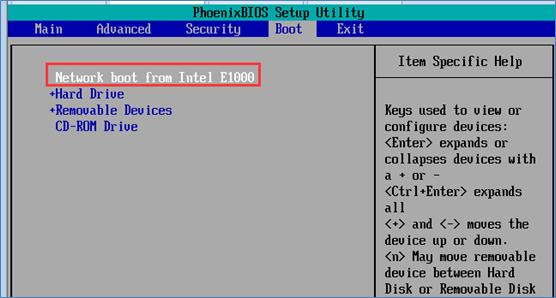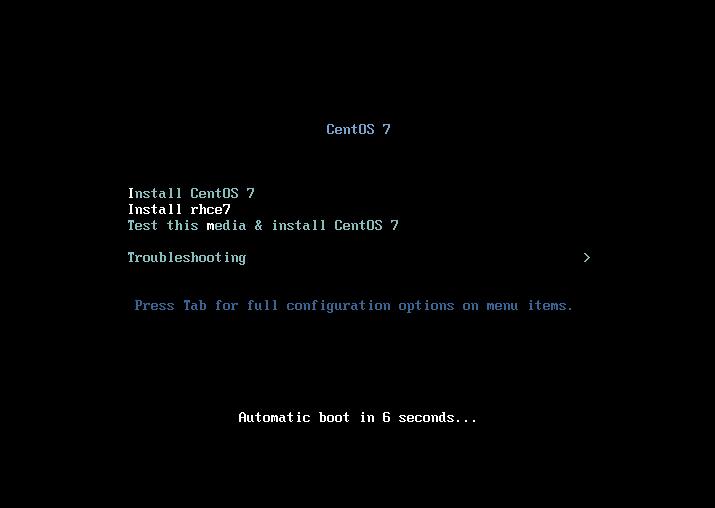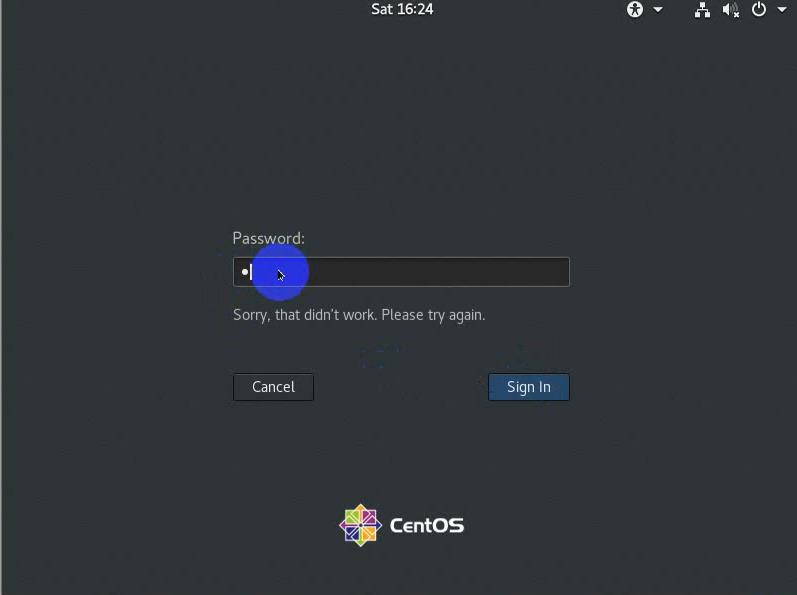VMware实现PXE+kickstart无人值守安装Centos7系统
Posted 宝山的博客
tags:
篇首语:本文由小常识网(cha138.com)小编为大家整理,主要介绍了VMware实现PXE+kickstart无人值守安装Centos7系统相关的知识,希望对你有一定的参考价值。
文章目录
PXE实现无人值批量部署服务器
一、PXE概述
1.1 什么是PXE
- PEX (Pre-Boot Execution E nvironment 预启动执行环境),是一种引导方式,并不是一种安装方式。
- 基于 Client/Server的工作模式
- PXE在网卡的ROM 中,当计算机引导时,Bios把PXE Client调入内存执行,PXE Client 将放置在远端的文件通过网络下载到本地运行。
1.2 什么是KickStart
-
KickStart 是一种无人值守的安装方式,KickStart 的工作原理是通过 记录典型的安装过程中记录所需要填写的各种参数(语言、时区、密码、分区、键盘等),并生成一个ks.cfg的文件。(名字可以修改,默认ks.cfg)
-
在其后的安装过程中,当出现要求填写参数的情况时,安装程序会首先去查找KickStart 生成的文件,当找到合适的参数时,就采用找到的参数,当没有找到合适的参数,就会卡着,需要人工干预。
-
如果KickStart 文件涵盖安装过程中所有需要填写的参数时,只需要告诉安装程序从何处取得 ks.cfg文件。安装完毕后,安装程序会根据ks.cfg中设置的重启选项重启系统,并结束安装。
1. 3 安装的必要条件
-
BIOS 支持PXE,需要在BIOS开启
-
NIC 网卡支持
二、PXE工作原理
2.1 工作原理
-
拓扑图
-
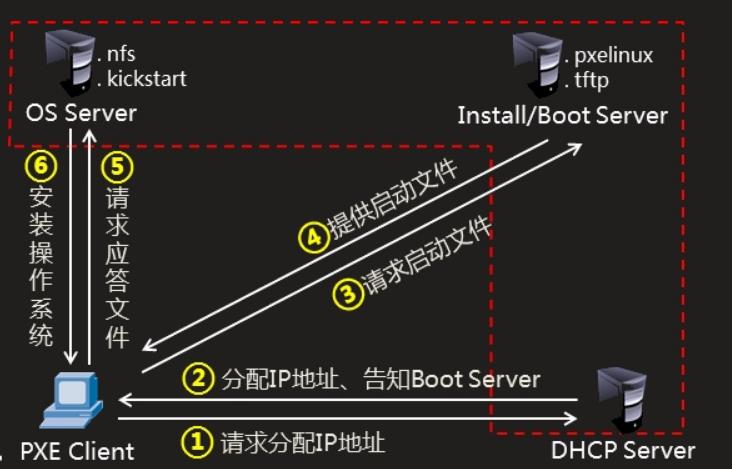
-
PXE工作原理
1.首先 PXE Client 向 DHCP 服务器发起请求分配IP(网卡需要向DHCP请求地址,获取信息) 2. DHCP 除了给你分配地址外,还会给你分配 boot-loader name(引导程序的名字) 以及Tftp 服务器IP地址 3.网卡使用Tftp 的客户端,向tftp服务器发起请求,把引导程序(pxelinux.0)加载到内存中来 4.然后 BIOS会执行这个引导程序。 5.引导程序会 boot-loader会从tftp去查找它的配置文件(default) 6.根据配置文件来引导
2.2 本次实验环境
-
实验环境
主机名 网络模式 IP地址 Server 仅主机
vmware 需要关闭DHP10.0.0.100 Client 仅主机 DHCP分配
2.3 执行PXE+KiskStart安装需要准备内容
-
DHCP 服务器 用来给客户机分配IP
-
TFTP 服务器 用来存放PXE 的相关文件:系统引导文件
-
FTP|NFS|HTTP服务器 用来存放系统安装文件
-
KickStart所生成的ks.cfg配置文件
-
带有一个 PXE支持网卡的 将安装的 主机
三、安装步骤
3.1 配置YUM源
-
YUM 源配置
[root@Server~]# cd /etc/yum.repos.d/ [root@Server/etc/yum.repos.d]# ls rivers.repo [root@Server/etc/yum.repos.d]# mv rivers.repo rivers.repo.bak [root@Server/etc/yum.repos.d]# vim dvd.repo [development] name=Centos7.6 baseurl=file:///mnt enabled=1 gpgcheck=0 [root@Server~]# mount /dev/cdrom /mnt/ mount: /dev/sr0 is write-protected, mounting read-only [root@Server~]# [root@Server~]# yum clean all Loaded plugins: fastestmirror Cleaning repos: development Other repos take up 137 M of disk space (use --verbose for details) [root@Server~]#
3.2 关闭防火墙、selinux
-
关闭防火墙、selinux
[root@Server~]# systemctl disable firewalld --now [root@Server~]#setenforce 0 # selinux 开机才生效,setenforce 0 临时关闭
3.3 安装DHCP 、tftp(tftp-server、xinetd)
3.3.1 安装dhcp、tftp-server、xinetd
-
安装dhcp、tftp-server
[root@Server~]# yum -y install dhcp tftp-server xinetd Loaded plugins: fastestmirror Loading mirror speeds from cached hostfile Resolving Dependencies --> Running transaction check ---> Package dhcp.x86_64 12:4.2.5-68.el7.centos.1 will be installed ……
3.3.2 配置DHCP服务
-
配置DHCP文件
# 1.进入 dhcp目录 [root@Server~]# cd /etc/dhcp/ [root@Server/etc/dhcp]# ls dhclient.d dhcpd6.conf scripts dhclient-exit-hooks.d dhcpd.conf # 2.查看默认配置文件,是空的,但是/usr/share/doc/dhcp*/目录下有配置模板,我们可以拷贝 [root@Server/etc/dhcp]# cat dhcpd.conf # # DHCP Server Configuration file. # see /usr/share/doc/dhcp*/dhcpd.conf.example # see dhcpd.conf(5) man page # [root@Server/etc/dhcp]# # 3.拷贝dhcpd 配置模板文件 [root@Server/etc/dhcp]# cp /usr/share/doc/dhcp-4.2.5/dhcpd.conf.example /etc/dhcp/dhcpd.conf cp: overwrite ‘/etc/dhcp/dhcpd.conf’? y # 4. 修改dhcp 文件,(这里可以不用拷贝配置文件,直接复制下面一段。subnet--filename) # A slightly different configuration for an internal subnet. subnet 10.0.0.0 netmask 255.255.255.0 { range 10.0.0.120 10.0.0.200; option domain-name-servers 10.0.0.5, 10.0.0.6; option domain-name "example.com"; option routers 10.0.0.254; option broadcast-address 10.0.0.255; default-lease-time 600; max-lease-time 7200; next-server 10.0.0.100; filename "pxelinux.0"; } subnet 10.0.0.0 netmask 255.255.255.0 #宣告网段 range 10.0.0.120 10.0.0.200; #分配地址范围 option domain-name-servers: #dns配置,正常公司会有2个DNS我这里随意配的 option routers 10.0.0.254; # 设置网关的 option broadcast-address 10.0.0.255; # 设置广播地址 default-lease-time 600; # 默认租约时间,它的单位为秒 max-lease-time 7200; #最大租约时间,它的单位为秒 next-server 10.0.0.100; # tftp-server IP地址 filename "/pxelinux.0"; # 网络启动程序,(网络引导) # 5. 启动dhcp 服务器, [root@Server/etc/dhcp]# systemctl enable dhcpd Created symlink from /etc/systemd/system/multi-user.target.wants/dhcpd.service to /usr/lib/systemd/system/dhcpd.service. [root@Server/etc/dhcp]# systemctl start dhcpd [root@Server/etc/dhcp]# [root@Server/etc/dhcp]# netstat -lantup|grep :67 udp 0 0 0.0.0.0:67 0.0.0.0:* 8503/dhcpd [root@Server/etc/dhcp]# [root@Server/etc/dhcp]# cd [root@Server~]# @补充:如果全局配置了,子配置没配置,那么将读取全局设置 如果全局配置了,子的也配置了,那么将以自配置为准。
3.3.3 配置tftp服务
-
开启tftp服务
# 1.修改tftp配置文件 [root@Server~]# vim /etc/xinetd.d/tftp 将 disable = no 改为 yes #重启 xinetd [root@Server~]# systemctl restart xinetd.service [root@Server~]# netstat -lntup|grep :69 udp 0 0 0.0.0.0:69 0.0.0.0:* 9071/xinetd [root@Server~]#
3.3.4 安装syslinux,拷贝pxelinux.0文件
-
配置tftp-server在哪里
# 1.查找 pxelinux.0文件是那个包提供的 [root@Server~]# yum provides "*/pxelinux.0" Loaded plugins: fastestmirror Loading mirror speeds from cached hostfile syslinux-4.05-15.el7.x86_64 : Simple kernel loader ...: which boots from a FAT filesystem Repo : development Matched from: Filename : /usr/share/syslinux/pxelinux.0 syslinux-tftpboot-4.05-15.el7.noarch : SYSLINUX ...: modules in /var/lib/tftpboot, available for ...: network booting Repo : development Matched from: Filename : /var/lib/tftpboot/pxelinux.0 # 2.安装syslinux包,然候拷贝pxelinux.0文件到 tftp-server目录 [root@Server~]# yum -y install syslinux [root@Server~]# rpm -ql syslinux|grep pxe /usr/share/doc/syslinux-4.05/pxelinux.txt /usr/share/syslinux/gpxecmd.c32 /usr/share/syslinux/gpxelinux.0 /usr/share/syslinux/gpxelinuxk.0 /usr/share/syslinux/pxechain.com /usr/share/syslinux/pxelinux.0 [root@Server~]# # 3. 拷贝pxelinux.0 文件到 tftp-server 目录 [root@Server~]# cp /usr/share/syslinux/pxelinux.0 /var/lib/tftpboot/ [root@Server/var/lib/tftpboot]# ls pxelinux.0 # 4.创建一个目录,用来放启动配置文件 default的 [root@Server/var/lib/tftpboot]# mkdir pxelinux.cfg [root@Server/var/lib/tftpboot]# ls pxelinux.cfg pxelinux.0 [root@Server/var/lib/tftpboot]# cd pxelinux.cfg [root@Server/var/lib/tftpboot/pxe.cfg]# pwd /var/lib/tftpboot/pxelinux.cfg # 5.将 /mnt/isolinux/目录下面的所有文件都考到 /var/lib/tftpboot下面 [root@Server/var/lib/tftpboot]# cd -- [root@Server~]# cd /mnt/isolinux/ [root@Server/mnt/isolinux]# cp -a isolinux.cfg /var/lib/tftpboot/pxelinux.cfg/default [root@Server/mnt/isolinux]#cp * /var/lib/tftpboot/ -
验证
-
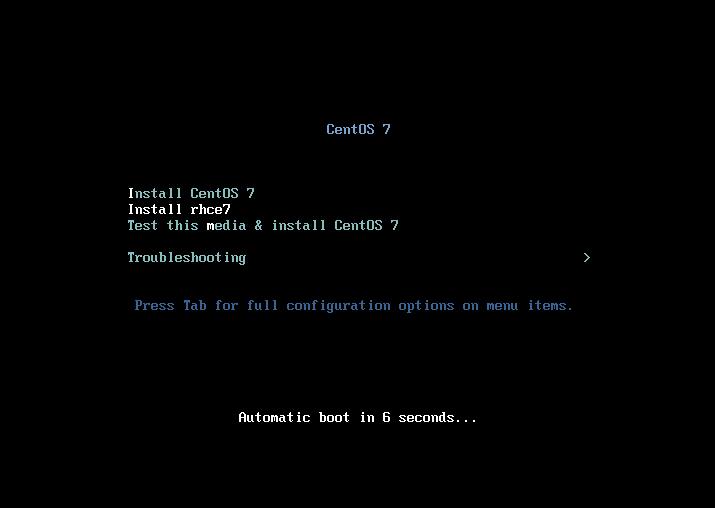
1.客户端启动系统,选择从网卡启动
2.就会从DHCP服务器(10.0.0.81)中获取IP地址,同时还获取了 tftp-server IP(10.0.0.81)地址和网络引导程序(pxelinux.0)
3.通过网卡读取到tftp-server(/var/lib/tftpboot目录)上的pxelinux.0,读取到内存中
4.在内存中执行引导程序
5.读取引导程序的配置文件(/var/lib/tftpboot/pxe.cfg/default)
3.4 编写kickstart.cfg配置文件
3.4.1安装system-config-kickstart
-
安装 system-config-kickstart
[root@Server/etc/yum.repos.d]# cd -- # 1. 安装system-config-kickstart [root@Server~]# yum -y install system-config-kickstart 已加载插件:fastestmirror, langpacks Loading mirror speeds from cached hostfile …… #2. 启动界面,配置ks.cfg [root@Server~]# system-config-kickstart 详解界面如下:
3.4.2 system-config-kickstart 界面配置
-
基本配置(默认语言、键盘、时区、密码、安装后重启)
-
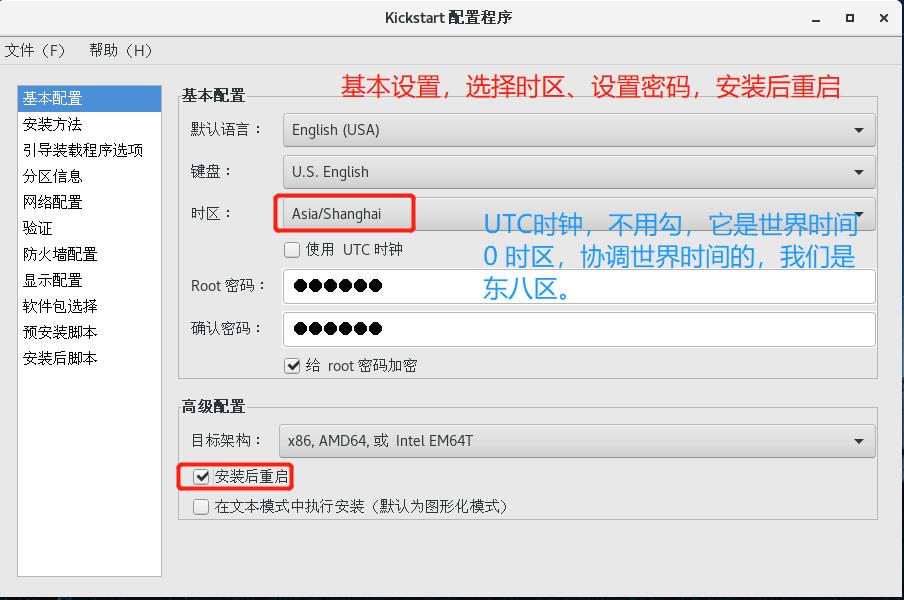
-
安装方法(全新安装、HTTP安装方式)
-
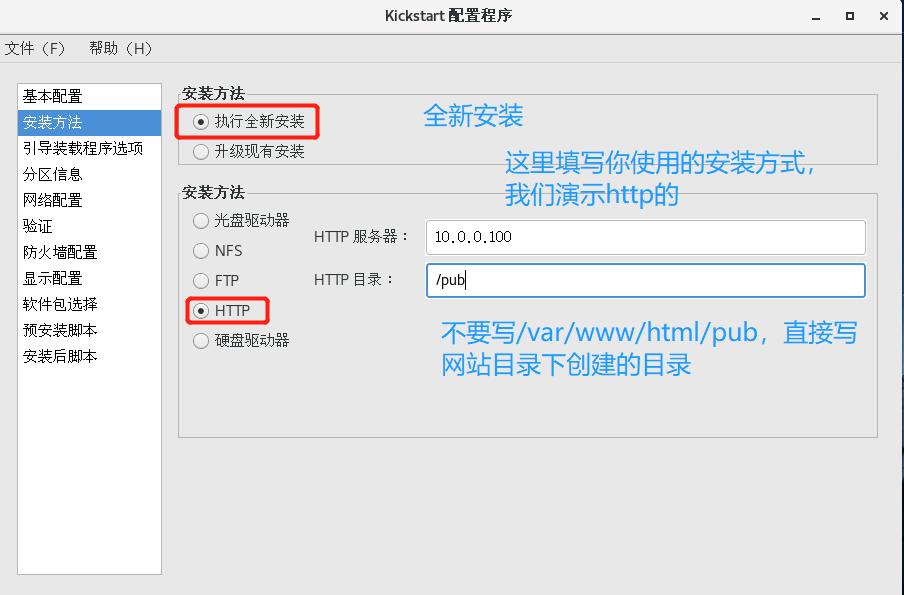
-
安装新引导装载程序
-
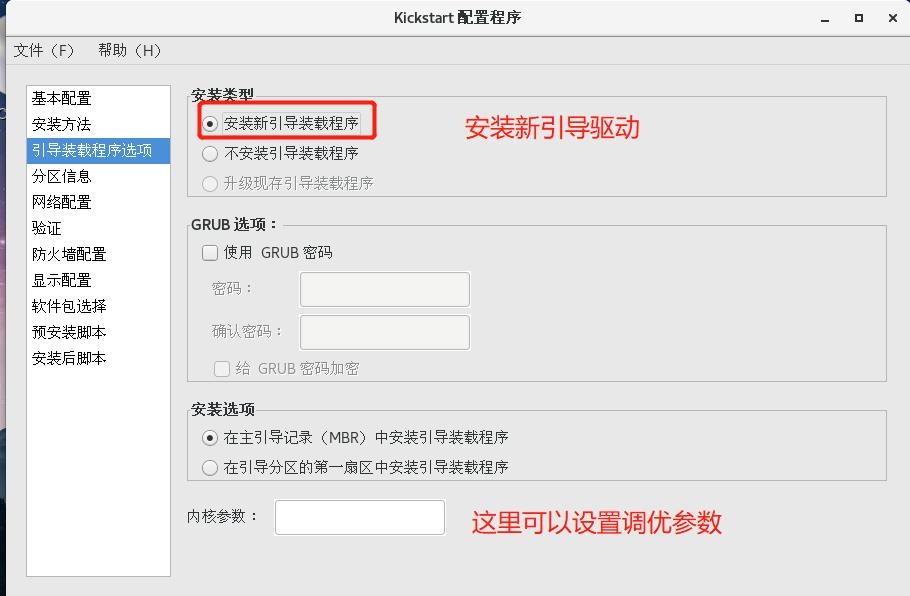
-
分区信息
-

-
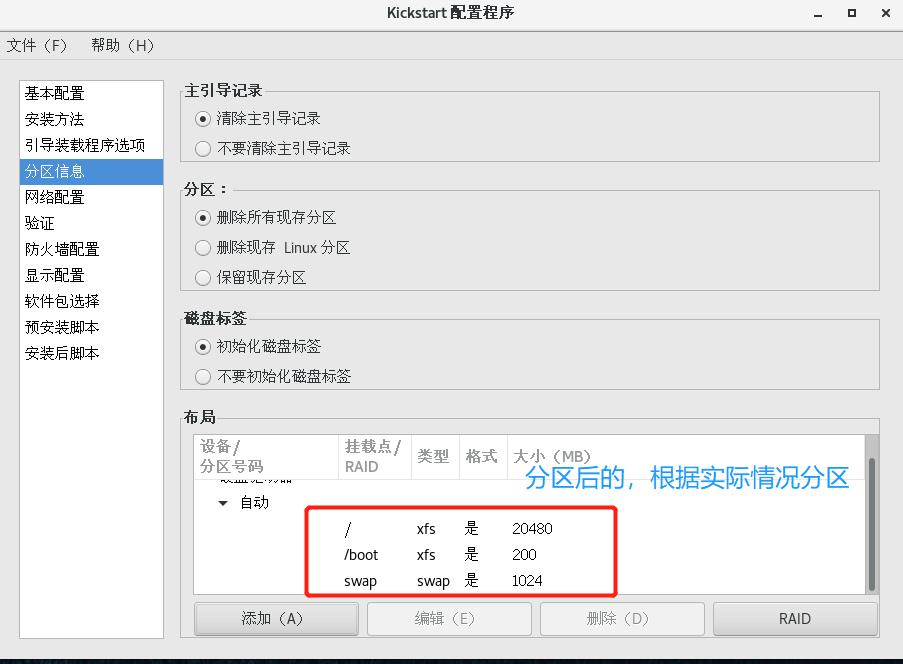
-
网络配置
-

-

-
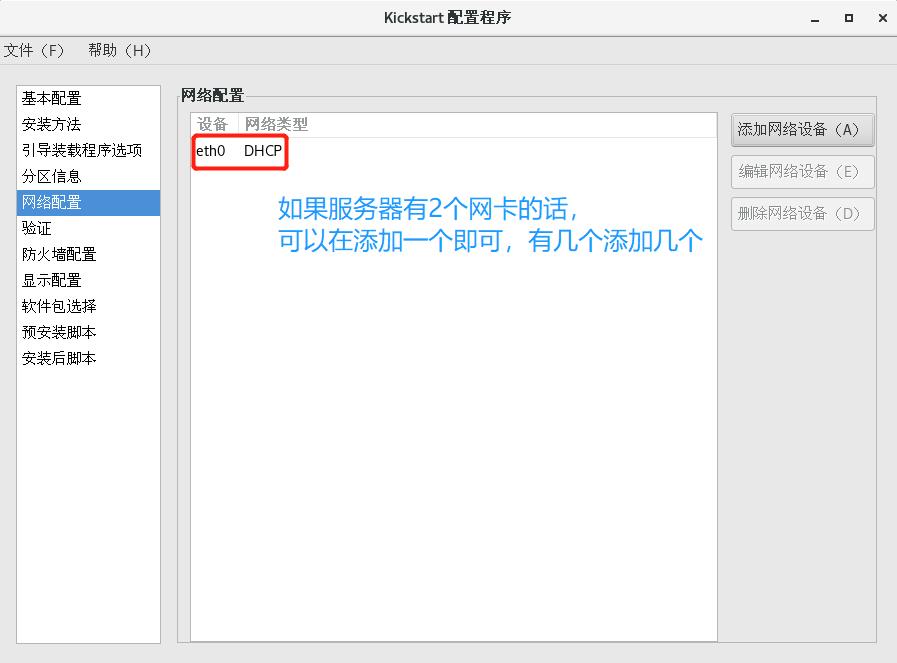
-
防火墙配置
-
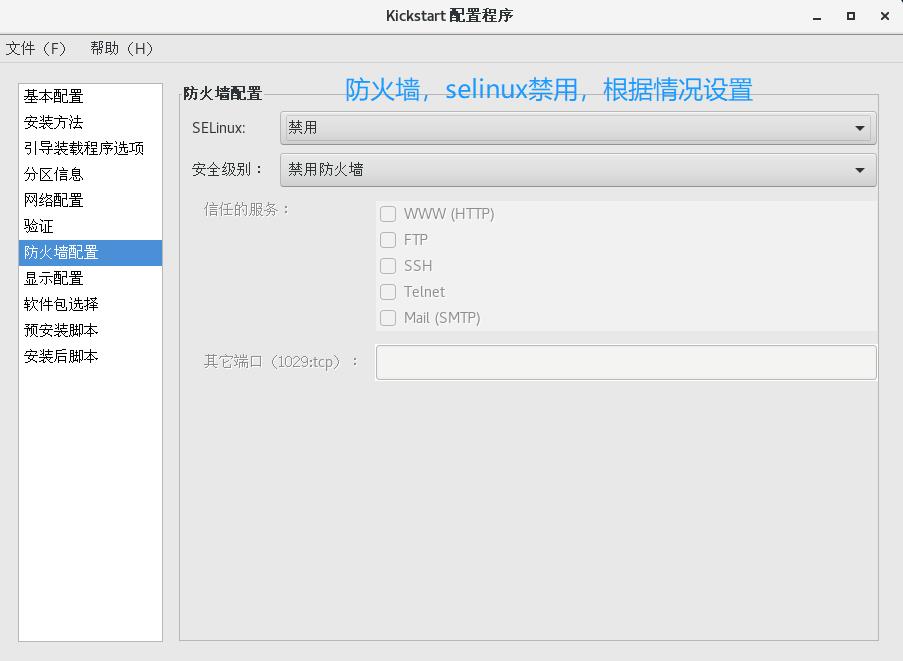
-
显示配置(是否安装图形界面)
-
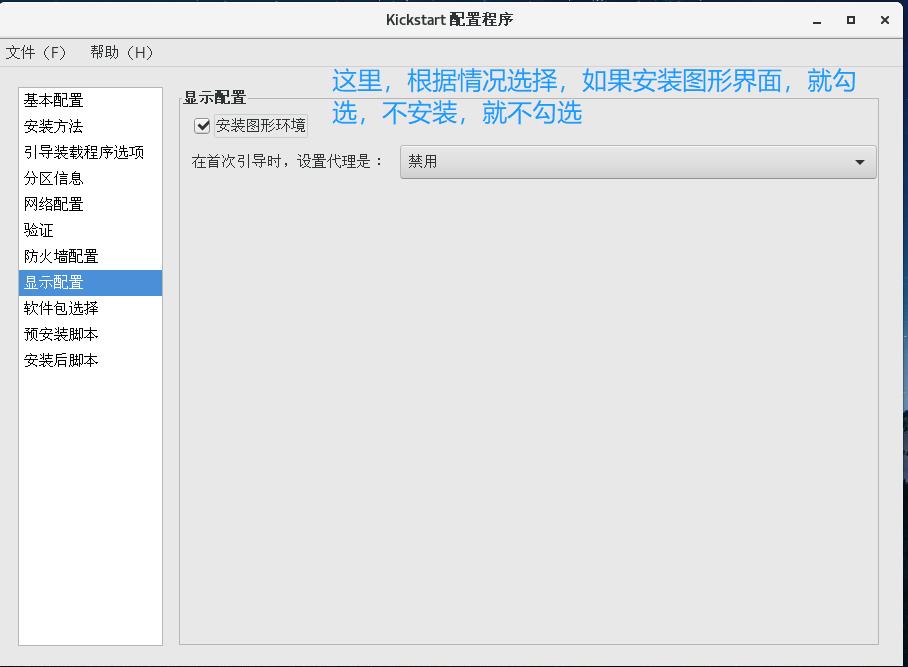
-
软件包安装选择
-
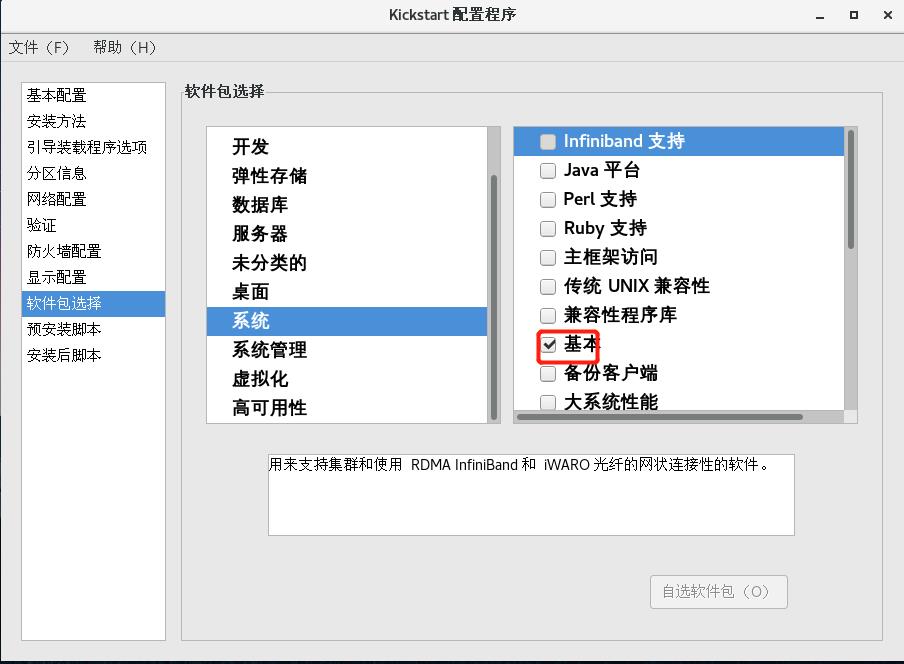
-

-
安装后脚本
-
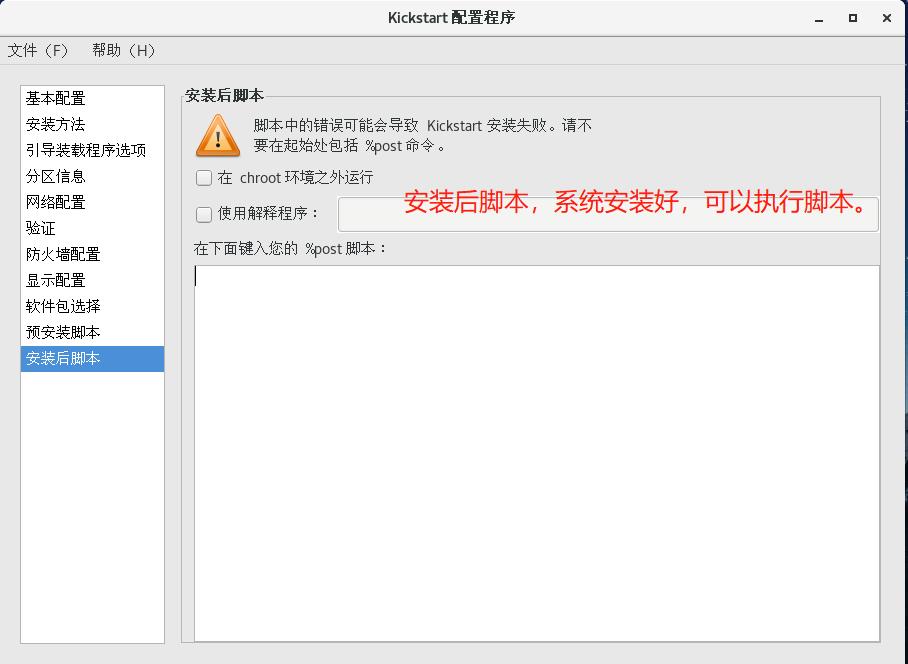
-
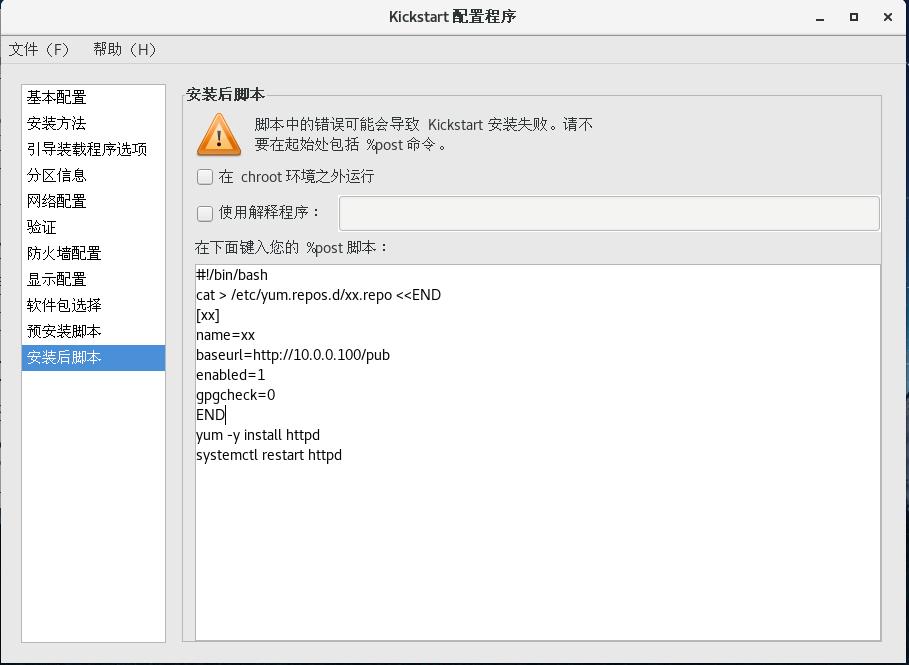
-
保存
-
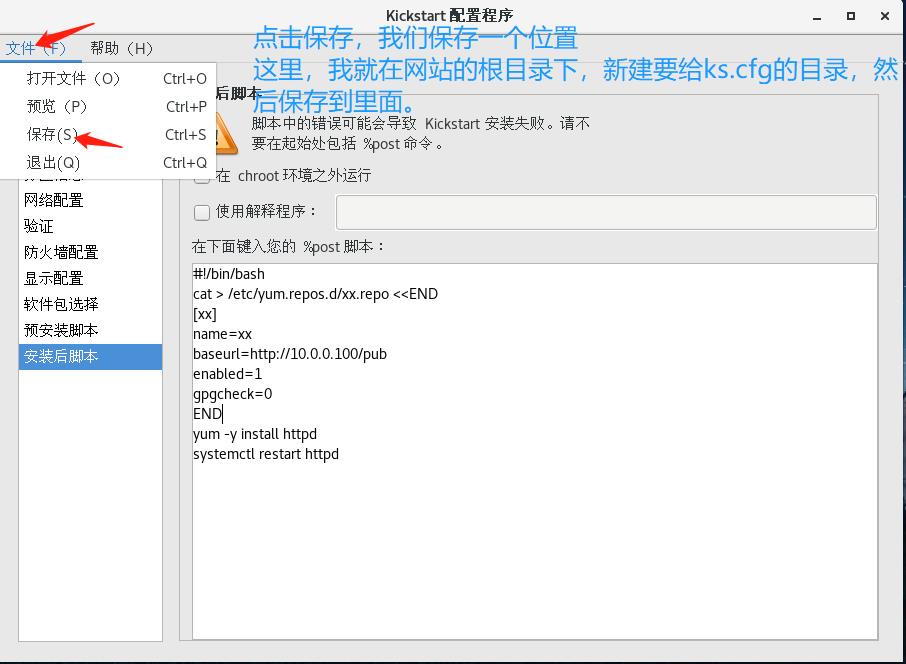
3.5 配置 HTTP镜像源
3.5.1 安装http
-
安装httpd
# 1. 安装httpd [root@Server ~]# yum -y install httpd 已加载插件:fastestmirror, langpacks Loading mirror speeds from cached hostfile …… # 2.设置开启自动、启动服务 [root@Server ~]# systemctl enable httpd [root@Server ~]# systemctl start httpd #3. 创建 目录 [root@Server ~]# cd /var/www/html [root@Server/var/www/html]# mkdir ks.cfg [root@Server/var/www/html]# mkdir pub # 4.修改yum 源,将本地改为http [root@Server/var/www/html]# cd [root@Server~]# cat /etc/yum.repos.d/dvd.repo [development] name=rhce7 baseurl=http://10.0.0.100/pub enabled=1 gpgcheck=0 [root@Server~]#
3.5.2 将iso 镜像文件挂在设置开机自启动
-
设置iso开机自启动
# 1. 在末尾添加以下一条信息。 [root@Server~]# vim /etc/fstab /dev/cdrom /var/www/html/pub iso9660 defaults,loop 0 0 [root@Server~]# tail -1 /etc/fstab /dev/cdrom /var/www/html/pub iso9660 defaults,loop 0 0 [root@Server~]# # 2.挂载镜像 [root@Server~]# mount -a # 3.用火狐浏览器访问下,如果可以访问,则说明http 镜像源没有问题 [root@Server~]# firefox http://10.0.0.100/pub & @ 7版本上,模式可以识别loop,defaults,loop 后面的loop可以省略
3.6 配置开机菜单 default
3.6.1 将ks6.cfg移动到 /var/www/html/ks
-
移动ks6.cfg
# 1.将我们保存在root目录中的cfg移动到 /var/www/html/ks.cfg/ [root@Server~]# mv ks6.cfg /var/www/html/ks.cfg/ [root@Server/var/www/html/ks.cfg]# ls ks6.cfg [root@Server/var/www/html/ks.cfg]#
3.6.2 配置开机菜单
-
编写defautl文件
[root@Server~]# cd /var/lib/tftpboot/pxelinux.cfg/ [root@Server/var/lib/tftpboot/pxelinux.cfg]# ls default # 1.编写default文件,此时在原本的label linux 添加以下内容, # 并删除label check里面的 menu defalut(默认启动方式,设置了,就不需要选择,默认启动选项) [root@Server/var/lib/tftpboot/pxelinux.cfg]# vim default label rhce7 menu label ^Install rhce7 menu default kernel vmlinuz append initrd=initrd.img ks=http://10.0.0.100/ks.cfg/ks6.cfg # 2.可以修改下默认的时间,默认是 600(单位是600秒的十分之一,就是60s) # 这里我设置60,就是6s timeout 60 ------------------- 参数介绍 efault vesamenu.c32 # 这是必须项,或者使用menu.c32 timeout 60 # 超时等待时间,60秒内不操作将自动选择默认的菜单来加载 display boot.msg # 这是为选项提供一些说明的文件 # Clear the screen when exiting the menu, instead of leaving the menu displayed. # For vesamenu, this means the graphical background is still displayed without # the menu itself for as long as the screen remains in graphics mode. menu clear menu background splash.png # 背景图片 menu title CentOS 7 # 大标题 menu vshift 8 …… label linux menu label ^Install CentOS 7 # 菜单文字 kernel vmlinuz # 内核文件路径,注意相对路径是从tftp的根路径/tftpboot开始的 append initrd=initrd.img inst.stage2=hd:LABEL=CentOS\\x207\\x20x86_64 quiet # 内核启动选项,其中包括initrd的路径,同样要改为"ks=http://10.0.0.100/ks.cfg/ks6.cfg" menu default # menu default表示开机时光标一开始默认停留在此label上 # 一般pxe环境下此路径直接指向系统安装文件的路径,具体做法见下文示例 # utilities submenu # 子菜单项的设置方法 menu begin ^Troubleshooting menu title Troubleshooting
3.6.3 将客户机 设置网络启动(raid等),开机启动即可
四、总结
所谓的无人值守,就是自动应答,当安装过程中需要人机交互提供某些选项的答案时(如如何分区),自动应答文件可以根据对应项自动提供答案。但是,无人值守并不完全是无人值守,至少设置bios从网卡启动是必须人为设置的,且安装完系统后设置不从网卡启动也是需要人为设置的。除此之外,其他的基本上都可以实现无人值守安装。
在部署时,建议使用 Kickstart+DHCP+HTTP(FTP)+TFTP,安装dhcp、tftp-server、xinetd、httpd、system-config-kickstart等软件。
在真实环境中,通常我们会发现一台服务器好几块硬盘,做完raid,整个硬盘有等10T,如果来使用kickstart自动安装并分区呢;一般服务器硬盘超过2T,如何来使用kickstart安装配置呢?这里就不能使用MBR方式来分区,需要采用GPT格式来引导并分区。需要在ks.cfg末尾添加如下命令来实现需求:
%pre
parted -s /dev/sdb mklabel gpt
%end
以上是关于VMware实现PXE+kickstart无人值守安装Centos7系统的主要内容,如果未能解决你的问题,请参考以下文章
VMware实现PXE+kickstart无人值守安装Centos7系统
VMware实现PXE+kickstart无人值守安装Centos7系统
